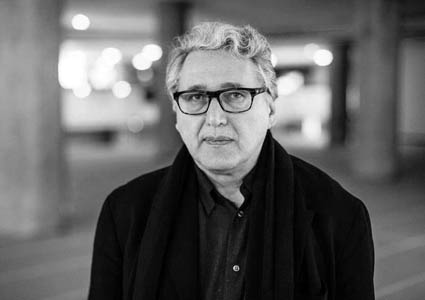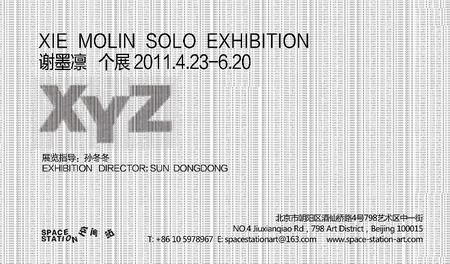
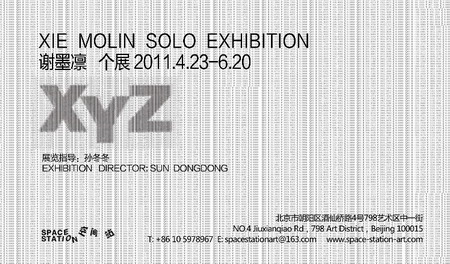
谢墨凛的自动绘画机与它制作的“视觉之物”之间是何种关系,或者说,这种关系应该在何种范畴之下进行表述才更为精确——这些来自外界的疑问暂时都被艺术家本人搁置在了一旁,因为对于谢墨凛来说,这些都是在他制造并开始使用机器以后的追问,而在这之前,如何制造出一台他设想中的机器才是他关注的全部问题。
在这个问题尚未成为问题的时候,谢墨凛的艺术实践同许多学艺青年一样,与个人的求学生涯交互在一起。无论是在国内的中央美术学院,还是在英国爱丁堡留学期间,谢墨凛的平面作品都有着强调艺术自律性的形式特征,从中既能看到他对于媒介材料的物质性所抱有的浓厚兴趣,也能发现一条他关于秩序感以及由此衍生出的视觉可能性的实践轨迹。虽然,无可否认这些作品多少携带着一股课堂作业般的气息和正趋流行的学院新做派,但对于谢墨凛现在的实践来说,一个稍长的前导过程业已澄清了他在语言形式上的美学态度,并且在英国留学期间,他切身体验到艺术与自然学科跨界交流所带来的启发,而这正是谢墨凛不止一次提到的制造自动绘画机器的原动力。
谢墨凛的自动绘画机器的灵感来自于他所使用过的刻字机。刻字机是目前广告装饰业中极为常见的一种输出设备。用户首先通过安装在电脑中和刻字机匹配的图文编辑处理软件,输入所需的文字,并且设置好所需要的字体和字号,或者制作好所需要的矢量图形。在完成所需的刻制内容设计之后,用户通过电脑向刻字机发出指令,最为常见的刻制对像是即时贴。而艺术家一般使用刻字机是为了与平涂或喷绘技术相结合,以求在平面上获得一种极致的超平、硬边等视觉效果。谢墨凛当然不是第一个使用刻字机的艺术家,但他想到去改造它,这不是什么苹果落在头顶的灵光乍现,相反的它恰能对应着深埋在艺术史中有关媒介工具偶尔提及又时常忽略的伏笔——媒介技术的推进对于视觉艺术的影响。
虽然,刻字机与自动绘画机器的工作原理相近,同属于XYZ三轴联动电脑输出设备,但完成从前者向后者的转化,谢墨凛却花费了三年的时间,其困难在于一方面受限于谢墨凛自身的经济状况,另一方面则是国内的艺术与科技之间的合作缺少有效的途径,借用谢墨凛自己的说法,他制造自动绘画机器的过程显得很“山寨”。“山寨”在谢墨凛这里并不指向某种美学上的修辞,而是在暴露出他的先天不足,不仅是在形容局促的客观条件,也是在表述他在初始阶段持有的那种非科学式的思考模式,这也就决定了谢墨凛不得不阶段性的去实现他设想中的自动绘画机。目前这台最新的机器属于第二代,相比于前一代,它从直观上已经非常接近现代工业机床,其实质性的突破表现在它可以自动制作弧线、塑造多样的空间关系以及拥有令人接受的工艺精度。但第二代机器仍是一台“半自动”机器,比如它并未安装自动的颜料出料控制系统,所以,颜料摆放在画布上的步骤还必须通过手工作业来完成。
第二代机器的完成使得谢墨凛对于自动绘画机的制造工作暂时告一段落。而当谢墨凛开始将注意力转向机器的制作之物的时候,他必然会遭遇到本文开始时的提问——他目前所进行的基于机器平台的实践到底是对其“机器”进行的某种质量评测,还是一种独立的艺术实践。如果是后者,那么他的自动绘画机很可能被指认为一种另类的绘制工具,另一种人手的延伸。只是这样的疑问大多来自画廊的经营者,他们考虑问题的逻辑原点设定在到底要卖什么,是机器,还是机器出的“产品”,就像谢墨凛自嘲的那样,机器与他后续的实践之间成了“母鸡与蛋”的关系。有趣的是,谢墨凛的自嘲很容易联想到“先有蛋还是先有鸡”的古老争辩。而如果将他的实践纳入到这一逻辑中加以追问,或许,之前的问题就变得不那么令人纠结。因为在面对这种“发生学”问题的时候,我们会更加留意其实践的整个过程,而这也是对谢墨凛的艺术实践进行价值判断的关键之处:自动绘画机以及基于这一平台的后续实践,实际上是谢墨凛对他之前视觉实验纯粹性的一次引申,其中包涵着对多样性的建构(物质层面),也有对精确性的诉求(表述层面),而当精度要求成为一种机械原理遵循的美学态度时,那么两者的关系就不应该再被割裂看待了。
在工作室,谢墨凛在机器的操作台面上铺好一幅画布,然后沿着它的边缘堆上厚厚的白颜料,再回到电脑前点击软件界面上的输出键,电机转动,XYZ三轴根据程序计算好的轨迹运行,锯齿刮板在颜料上划了一个“m”形。后来,这件作品被挂到展厅里,有观众发现每条弧线都很饱满,高度与间距又很平均,怀疑艺术家用了什么工具,当被告知这件作品是由机器制作的,观众表示很想看看这台机器。虽然,以上只是一种假设,但对于谢墨凛来说,他的这些零度质感的“视觉之物”如何让观众摆脱对于机器本身的好奇,才是他在未来实验中需要正视的一个根本性问题。
XYZ - Xie Molin Solo Exhibition
Exhibition Director :Sun Dongdong
Opening:16:00 April 23.2011.
Exhibiting Time:2011.4.23 -2011.6.20
Venue:Space Station
展览名称:XYZ—— 谢墨凛个展
展览总监:孙东东
开幕时间:2011年4月23日下午四点
参展时间:2011年4月23日至2011月6月20日
展览地点:空间站
XYZ—— 谢墨凛个展
2011年4月23日空间站将为青年艺术家谢墨凛举办首次个展《XYZ》。由青年批评家孙冬冬担任展览指导。
谢墨凛2003年毕业于中央美术学院壁画系,2007年获得英国爱丁堡艺术学院绘画艺术系硕士学位,回国后居住并创作于北京。此次展览的作品是艺术家回国后的最新创作。
展览取名《XYZ》,直接的表意是指这些作品不仅是单纯的二维平面,还有第三维的突起效果,而这三个维度密不可分地构成了作品的整体视觉体验。另一层涵义是指谢墨凛发明的、与这些作品有关的一台XYZ三轴联动绘画机。
艺术家在工作室中经过无数次试验、失败、再试验,最终完成这些作品后,在展厅中,它们则完全交给了观众的眼睛。这里没有现实的简单对应、道德的作伪说教、灵魂的阴暗解剖或者哲学的牵强隐喻,并不是说艺术家不关心现实、道德、灵魂和哲学的问题,而是这些问题被艺术家谨慎地搁置和谨慎地选用。在艺术家眼里,艺术有着更为独立而抽象的功能,色彩、光影、空间、结构等等这些绘画中的老问题,是其一直秉持、不断思考并力求突破与创新的关键点。
当然,视野仅仅局限于绘画的老问题,是不够而且容易令人疲倦的(不仅指观众,也包括艺术家)。事实上,谢墨凛从大学本科开始,就显示出对于传统绘画方式的怀疑,当时最有代表性的作品即艺术家将自己数日临摹在铝板的靳尚谊名作《塔吉克新娘》从背面向铝板喷火加热导致颜料融化坍塌,而成为了一张没有叙事没有技巧的抽象画。如何在绘画中运用艺术之外的手段尤其是机械工具和电脑技术,为绘画创造出新的可能性和画面效果,谢墨凛决定搁置画笔而转向其他绘画工具的研究。2001年在北京的一次格哈德•里希特的展览上,西方绘画大师使用替代性绘画工具创造出的全新的丰富效果,使谢墨凛受到了很大的刺激和鼓舞。
在随后的日常实验和创作中,艺术家注意到了刻字机与电脑结合产生的绘画功能,以此延伸,通过将电脑制作的图案镂刻在不干胶上,再以逐层揭掉不干胶铺施丙烯颜料的方式最后实现图案细密工整的画面效果,这样的一批作品远观如波斯地毯一般拥有强烈的装饰性,近看局部则是非常个人化的图像(如色情图像和自杀的小人)。这样的方式结合了电脑绘图的可重复性、刻字机的精确性以及具体到制作过程中密集的艺术家劳动,产生了仅仅依靠某一种手段(电脑或人手)不可能达到的效果。谢墨凛甚至空运了一台刻字机到英国,以便在研究生阶段继续这一创作方式的深入,更注重画面空间的营造。其研究生阶段作品《黑与灰》(2007年)一张就耗时五个月,并获得了当年苏格兰皇家学院颁发的“苏格兰未来之星大奖”。刻字机的刀头被艺术家换成铅笔、马克笔甚至毛笔,同样输出在电脑中精心绘制的图像,这样的一批小幅纸上作品相比大尺寸的布面丙烯作品更加突出绘画感,笔触繁密,色调轻盈而愈发引起人们细腻的情感。
西方的艺术环境似乎与谢墨凛的艺术兴趣更为契合,在其研究生毕业论文中,谢墨凛写道:“在英国和欧洲,由于长期的科技氛围,许多艺术家将其他领域的技术应用到艺术创作中,如英国的Boyle家族和Christine Borland。甚至在更长远的历史中,如维米尔通过自制的镜像工具绘制出高超的画作,技术和艺术的关系都是密不可分的。而在中国,同样也是传统和历史的缘故,艺术与科技的交互仍是个新课题。如果说刻字机是我的第一台绘画机器,那么我有没有可能发明出更多可能性的绘画机器呢?”
如果说艺术家是带着这样的问题回到国内的环境中,那么观众在这次展览中看到的便是阶段性的答案。这一台并没有出现在展览现场的机器,其两年多的制作过程本身就可以说是一个艺术项目,其中除了纯艺术和技术层面的问题,还包裹了理想主义和现实之间的种种冲突,折射出社会现实和人性的各个侧面,成为了这台机器不经意间附加的人文涵义,而这些故事将会在后面出版的画册中由艺术家娓娓道出。
技术和艺术有关系,但没有绝对的关系;就如同绘画机器和画作有关系,但也没有绝对的关系。毕竟机器永远只是辅助工具,离开艺术家,只不过是堆零件而已。从最初受一把刮刀随意刮出的效果的启示,到最终一台颇具规模的绘画机器的完成,谢墨凛要如何设定并控制最终画面的效果,全在于无数次的试验和拓展。回到展览中的作品,同样都是电脑和机器制作,但绝不是简单的复制和输出,而是使用多样的方式赋予每一幅作品各自的特点,它们都是独立自在而与他物无关的,而且几乎每一件作品都需要观者在作品前变换不同的角度观看。《辙》系列是其中较早的作品,侧面角度观看时分明而均匀的明暗效果造成的立体感是这一类作品的特点。《平流层》由颜色的均匀渐变和突起的疏密不同来营造观者的想象空间。《淼》中最吸引人的是颜料开裂后形成的波纹般的效果。《棘》系列是两层不同颜色的颜料叠加在一起的结果,下层颜料部分泛出在第一层颜料上,细节生动。《双》和《比》是一组黑白系列,大颗粒的突起在光线下产生明暗效果,同一画面上的单色却能产生两种视觉。《甡》和《赫》是较近的作品,同样使用单色,突出的是机械绘画的绝对对称性以及由此产生的精致感和炫目感。
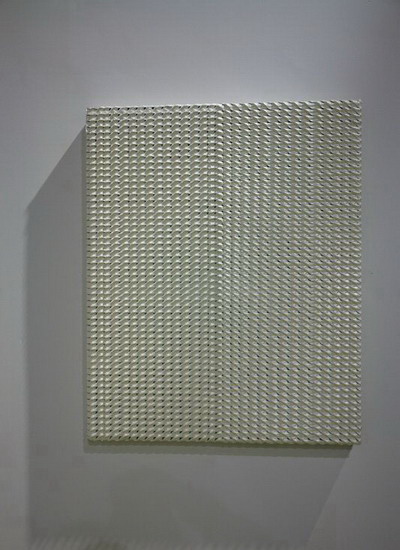
展览现场
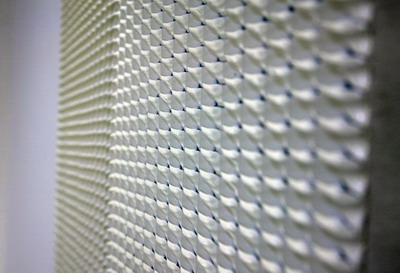
展览现场
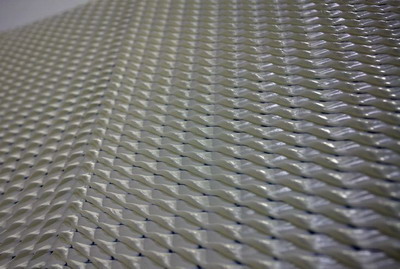
展览现场
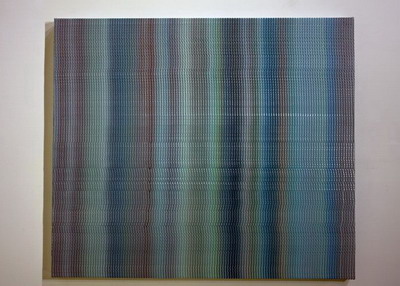
展览现场
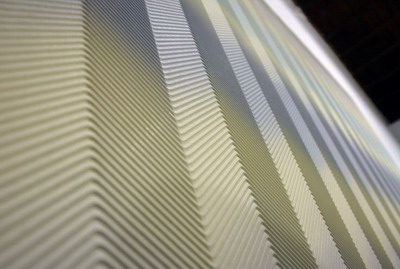
展览现场

展览现场
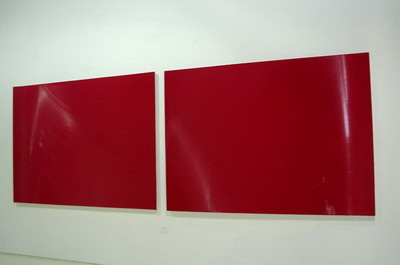
展览现场
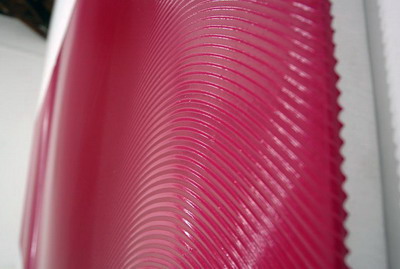
展览现场
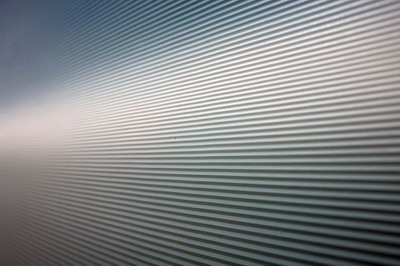
展览现场
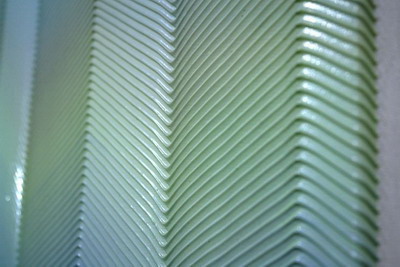
展览现场
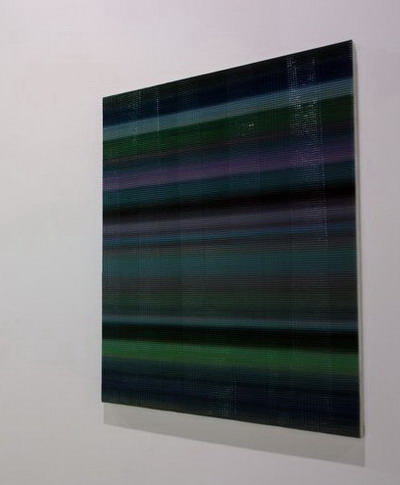
展览现场
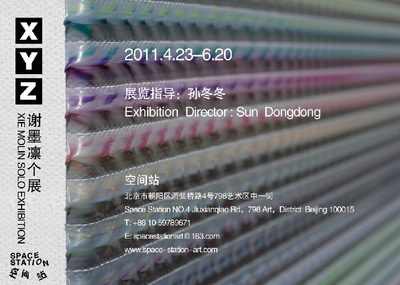
XYZ
Sun Dongdong
What is the relationship between the automatic drawing machine created by Xie Molin and "visual works" created by it? Or in what scope could this relationship be expressed more accurately. These doubts from the outside world have been temporarily set aside by the artist himself. Because for Xie Molin, these were the questions asked after he has made and begun to use the machine. While before this, only how to make one machine he conceived was all of his concerns.
When this doubt has not been a real question, Xie Molin's art practices were the same as many youths learning art and interacted with his personal learning life. No matter studying in domestic Central Academy of Fine Art or while studying in Edinburgh aboard, all of Xie Molin's graphic works had formal characteristics emphasizing on self-regulation of art, from which we can not only see his strong interest in the material property of the medium materials, but also find out a sense of orderliness and the visual possibilities of practice path derived from it. Although we could not deny these works more or less carried a smell of class assignments and increasingly popular new academic style, for Xie Molin's current practices, a slightly longer preceding process has clarified his aesthetics attitude to language form. What's more, during studying aboard in England, he experienced in person the inspiration brought about by the cross-border exchange between the art and nature disciplines, while this just was the motive power to drive Xie Molin to propose more than once the creation of automatic drawing machine.
Xie Molin's automatic drawing machine was inspired by his used carving machine. Carving machine is a very common output device used in ad décoration industry at present. Firstly, user inputs the needed character and sets the needed font and sizes, or makes the needed vector graphics through graph-text editing processing software matching the carving ma chine and installed in the computer. After completing the design for all the needed carving contents, user sends instructions to the carving machine via computer. The most common carving object is stick note. Generally, the artists use the carving machine to combine it with flat coated and spray painting techniques so as to obtain a kind of visual effects of supreme supper level and hard edge in a the plane. Of course, Xie Molin was not the first artist who used the carving machine. But, he wanted to transform it. This was not what flash of genius gained from apple hitting on the head. Instead, it exactly corresponded to the occasionally mentioned and often overlooked foreshadowing buried deeply in relative medium tools in the art history——the impact of the advancement of medium technology on visual art.
Although the carving machine's working principle is similar to the automatic drawing machine's and both of them belong to XUZ three-axis linkage computer output devices. But Xie Molin spent three years to complete the transformation from the former to the latter. The difficulty, on one hand, was limited to Xie Molin's own economic situation. On the other hand, it was due to lack of effective ways of cooperation of domestic art and technology. Just as Xie Molin's statement, the process he made the automatic drawing machine looked very "Shanzhai". "Shanzhai" here did not mean some rhetoric in aesthetics but revealed his inherent shortages. "Shanzhai" not only described the hasty objective conditions but also presented that kind of non-scientific thinking mode he held in the initial stage. This also determined Xie Molin had to periodically realize his imagined automatic drawing machine. At present, this latest machine belongs to the second generation. Compared with the former generation, it has been very close to the modern industrial machine tool intuitively. Its substantive breakthrough is that it can automatically make arc line, create diverse spatial relationships and own acceptable process accuracy. But the second generation machine is still a "semi-automatic" machine. For example, no automatic pigment outward control system is installed in it. Therefore, the steps to put the pigment on the canvas still must be completed by manual work.
The completion of the second generation of the machine made Xie Molin's creation work on the automatic drawing machine temporarily come to an end of a stage. However, when Xie Molin began to turn to pay his attention to the productions of the machine, he certainly encountered the questions in the beginning of this article ——what he is practicing based on machine platform currently is performing some quality assessment of the "machine " or a kind of independent art practice on earth. If it is the latter one, his automatic drawing machine is largely likely to be identified as an alternative drawing tool and the extension of another kind of human hands. But, such questions mostly are from the operators of the gallery. The set logical origin point of the question they consider is what to sell on earth, machine or "products" produced by the machine. Just as Xie Molin's self-mockery, the machine and his follow-up practices become a relationship of "hen and egg". Interestingly, Xie Molin's self-mockery makes easily the old argument on "which came first, the egg or the chicken" associated with. However, if his practices are to be incorporated into this logic and asked, maybe, the previous question will become not so entangled. Because when facing this "genetics" problem, we will pay more attention to his whole practice procedure, while this also is the key point to the value judgments of Xie Molin's art practices. The automatic drawing machine and the follow-up practice based on this platform are actually a pure meaning extended to his previous visual experiments by Xie Molin, including the construction of diversity (material level) and accuracy appeals (expression level), while when accuracy requirements become a kind of aesthetic attitude followed by the mechanical principle, the relationship between the two shall not be viewed separately.
In the studio, Xie Molin put a piece of canvas on the operation table. Then, he stacked a thick of white pigment along its edge and then came back to be in front of the computer and clicked the output key on the software interface. The motor rotated and XYZ axis ran following the track calculated by the program. The serrated scraper painted a "m" shape in the pigments. Later, this work was hanged in the exhibition hall. Some audiences found the arc lines were very full with very mean heights and intervals and thus doubted what tools must be used by the artist. When they were told this work was made by a machine, the audiences showed their willing to see this machine. Although the above is only an assumption, For Xie Molin, how his zero texture "visual works" to be clear of the audiences' curiosity on the machine itself is a fundamental problem he needs to face up to in the future experiments.
T: +86 10 59789671
W: www.space-station-art.com
E: spacestationart@163.com
Address: Space Station,NO.4 Jiuxianqiao Rd,798 Art Zone,Chaoyang District Beijing 100015

